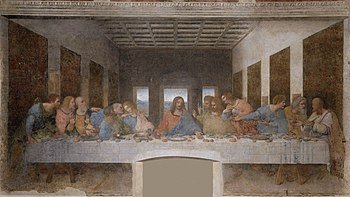The Historical Significance and Deterioration of ‘The Last Supper’
Leonardo da Vinci’s ‘The Last Supper’ stands as one of the most significant and revered works of art in Western history. Painted between 1495 and 1498, it was commissioned by Ludovico Sforza, Duke of Milan, and adorns the wall of the Convent of Santa Maria delle Grazie in Milan. The mural captures the pivotal moment when Jesus announces that one of his disciples will betray him, a subject that has enthralled viewers for centuries due to its dramatic intensity and emotional depth.
Despite its monumental status, ‘The Last Supper’ has endured a troubled history, marked by deterioration and misguided restoration efforts. Initially, Leonardo’s experimental technique contributed to the mural’s vulnerability. Instead of the traditional fresco method, which involves applying pigments on wet plaster, Leonardo used tempera paints on a dry wall, seeking greater detail and luminosity. Unfortunately, this choice led to rapid degradation as the paint began to flake and fade soon after its completion.
The environmental conditions within the refectory of Santa Maria delle Grazie exacerbated the mural’s deterioration. Humidity, fluctuating temperatures, and exposure to pollution hastened the damage. Over the centuries, various restoration attempts were made, many of which were poorly executed, further compromising the artwork. In the 18th and 19th centuries, restorers applied layers of varnish and overpainted sections in an effort to preserve the image, inadvertently obscuring Leonardo’s original vision.
World War II brought additional peril to ‘The Last Supper’. In 1943, Allied bombings severely damaged the convent, leaving the mural exposed to the elements. Although protective measures were taken, including sandbagging the mural, significant damage occurred. By the late 20th century, the need for a comprehensive restoration was undeniable. The mural had lost much of its original detail and color, rendering it a shadow of its former glory.
These historical challenges underscored the urgent necessity for a meticulous and scientifically informed restoration. The 22-year restoration project, culminating on 28th May 1999, aimed to resurrect the masterpiece, ensuring that future generations could once again experience Leonardo’s profound depiction of this biblical scene.
The restoration of Leonardo da Vinci’s ‘The Last Supper’ began in 1977 and concluded in 1999, after 22 years of painstaking effort. The objective was to stabilize and preserve the surviving original material while eliminating layers of overpainting and accumulated grime. The work involved a combination of advanced scientific technologies and traditional art preservation techniques, aimed at reviving the masterpiece’s original splendor.
One of the pivotal techniques utilized was infrared reflectography, which allowed restorers to see beneath the surface layers and identify the original brushstrokes and composition. Additionally, X-ray fluorescence spectrometry was employed to analyze the chemical composition of the pigments, enabling the team to distinguish between Da Vinci’s original work and later additions. These advanced methodologies were complemented by traditional techniques, such as careful solvent cleaning and the application of reversible, conservation-grade materials.
The restoration process was not without controversy. Critics argued that some of the interventions might have altered the original essence of the mural, potentially causing loss of historical authenticity. Art historians and conservators debated whether the extensive cleaning and retouching might have introduced modern elements into the centuries-old artwork. Despite these concerns, the restoration team maintained that their primary goal was to preserve and stabilize the original material as faithfully as possible.
The positive outcomes of the restoration were significant. The removal of overpainting and dirt layers revealed Da Vinci’s original colors and intricate details, previously obscured over centuries. The restoration enhanced the appreciation and understanding of the artwork, providing new insights into Da Vinci’s techniques and intentions. As documented by authoritative sources such as the Italian Ministry of Cultural Heritage and Activities, the meticulous work brought ‘The Last Supper’ closer to its original state, allowing viewers to experience its historical and artistic value more profoundly.
The mural’s re-unveiling on May 28th, 1999, marked a pivotal moment for the art world and cultural heritage. The restored ‘The Last Supper’ stands not only as a testament to Da Vinci’s genius but also to the advancements in art conservation. It continues to attract scholars, art enthusiasts, and tourists, reinforcing its place as a cornerstone of Renaissance art and a symbol of meticulous preservation efforts.

